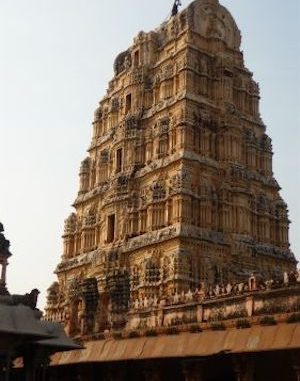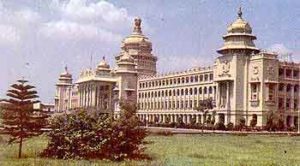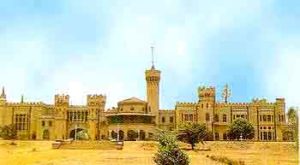
Called Karnadu (elevated land) in ancient times, Karnataka is made up of a series of uplands with an average height of 610 metres above sea level. The Bababudan range in the western ghats has one of the highest mountain peaks between the Himalayas and the Nilgiris. And boasting one of the wettest regions in India, at Agumbe, are the western ghats, rich in teak, rosewood and sandalwood. Karnataka is known for it’s legendary craftsmenship in sandalwood and rosewood. Swift flowing rivers criss-cross to create a network of water sources.
 The course of Karnataka’s history and culture takes us back to pre-historic times. The earliest find of the stone age period in India was an hand axe at Lingasugur in Raichur district. The Ashokan rock edicts found in the state indicate that major parts of Northern Karnataka were under the Mauryas. Chandragupta Maurya, the great Indian emperor abdicated his throne to embrace Jainism at Shravanabelagola.
The course of Karnataka’s history and culture takes us back to pre-historic times. The earliest find of the stone age period in India was an hand axe at Lingasugur in Raichur district. The Ashokan rock edicts found in the state indicate that major parts of Northern Karnataka were under the Mauryas. Chandragupta Maurya, the great Indian emperor abdicated his throne to embrace Jainism at Shravanabelagola.
Adding new dimensions to the cultural and spiritual ethos of the land, many great dynasties left their imprint upon the aesthetic development of Karnataka’s art forms. Prominent among them were the Chalukyas, the Hoysalas and the mighty Vijayanagara Empire. The Chalukyans built some of the very early Hindu temples in India, at Badami in Northern Karnataka, setting the trend and the style for structural temples. The Hoysalas who ruled from the 11th to the 13th century chiselled their way into the pages of glory by building more than 150 temples, each a marvel of sculptural skill. There is an amazing dexterity and fluidity of expression at Somnathpur, Halebid and Belur.Vijayanagara. The greatest of all medieval Hindu empires, intellectual pursuits and fine arts flourished.
 Under the enlightened rule of Krishnadevaraya, the empire rose to its zenith and was greatly appreciated by foreign travellers who came to the court of the king. Abdur Razaaq the Persian ambassador had remarked, “The eye of the pupil has never seen a place like it and the ear of intelligence has never been informed that there existed anything to equal it in the world”.
Under the enlightened rule of Krishnadevaraya, the empire rose to its zenith and was greatly appreciated by foreign travellers who came to the court of the king. Abdur Razaaq the Persian ambassador had remarked, “The eye of the pupil has never seen a place like it and the ear of intelligence has never been informed that there existed anything to equal it in the world”.
The Vijayanagar empire with its capital at Hampi fell a victim to the marauding army of the Deccan Sultan in 1565 A.D. As a consequence of this, Bijapur became the most important city of the region. This city is a land of monuments and perhaps no other city except Delhi has as many monuments as Bijapur. The Bahmani Shahis and the Adil Shahis of Bijapur have played a notable part in the history of Karnataka by their contribution to the field of art and architecture and also by their propagation of Islam in the state.
Hyder Ali and his valiant son Tipu Sultan are notable figures in the history of the land. They expanded the Mysore kingdom on an unprecedented scale and by their resistance to the British, became famous internationally. Tipu was a great scholar and a lover of literature. His artistic pursuits were also many and he made rich gifts to the Hindu temples. The tiger of Karnataka was killed in 1799 A.D., and the Mysore throne was handed over to the Odeyars.
The whole of Karnataka came under the control of the British in the beginning of the 19th Century. The new state was called new Mysore and the Maharaja of Mysore was appointed the Governor by Independent India. This unified state was renamed as Karnataka on November 1, 1973.
 The varied and tumultous history of Karnataka, coupled with architectural excellence and religious fervour has ensured that the state is of immense interest to the tourist. Nature has also not lagged behind in providing Karnataka with beautiful waterfalls, exotic beaches, thick wild forests and game sanctuaries. The state also offers excellent facilities for trekkers, anglers and golfers.
The varied and tumultous history of Karnataka, coupled with architectural excellence and religious fervour has ensured that the state is of immense interest to the tourist. Nature has also not lagged behind in providing Karnataka with beautiful waterfalls, exotic beaches, thick wild forests and game sanctuaries. The state also offers excellent facilities for trekkers, anglers and golfers.
Crafts
Karnataka is famous for its aesthetic craftsmanship in sandalwood and rosewood. Eye-catching items of furniture, in-lay work, coffee tables, wall hangings etc. are worthwhile purchases. Rich silks, wooden toys, leather puppets, Bidriware and other artefacts make ideal mementos.
Theatre
Karnataka’s folk theatre has an ancient and rich tradition, the two principal forms being Yakshagana and the puppet theatre. Yakshagana a powerful and vibrant spectacle is somewhat similar to the Kathakali tradition of Kerala in the choice of its elaborate costumes and vigorous dancing.
Bhootada Kunita (Dance of the Divine Cult), Nagamandala and the demon dance are some quaint rituals prevalent only in Dakshina Kannada coastal area and they embody the profound drama of life.
(Information courtesy Karnataka Tourism Department)


Leave a Reply